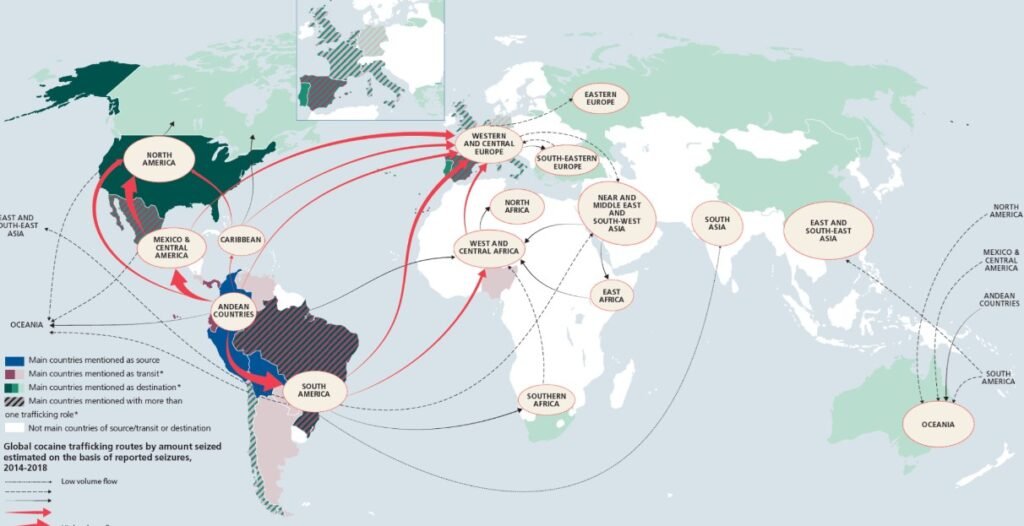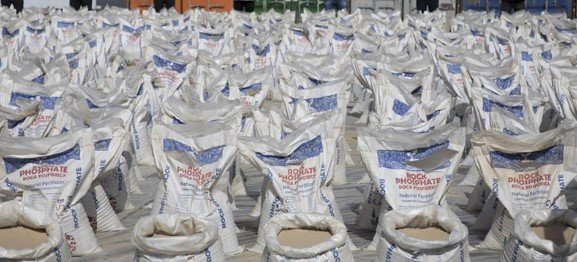Turkish and unfamiliar policing held onto record amounts of cocaine heading from South America to Turkey, uncovering the growing job of the country’s dealers in delivering medications to European and Middle Eastern business sectors.
In late June, Ecuadorean specialists held onto approximately 850 kilograms of cocaine at the port of Guayaquil from a compartment of bananas headed for Turkey, as per a police explanation. The shipment was practically indistinguishable from a different burden blocked in Turkey’s port of Mersin in April, likewise from Guayaquil and containing more than 250 kilograms of cocaine.
The seizures, as indicated by specialists counseled by InSight Crime, are only the tip of the criminal chunk of ice, as Turkish coordinated wrongdoing — long ruler of the European heroin exchange — progressively goes to cocaine to balance falling sedative costs.
And keeping in mind that still, auxiliary players in Europe contrasted with the Italian and Albanian mafias, Turkish organizations are currently starting to lead the pack in providing the world’s more modest however creating cocaine markets, driving South American powder into eastern Europe, the Caucasus and the rich petro-conditions of the Persian Gulf.
Beneath, InSight Crime inspects three justifications for why Turkey is the most recent cross-country cocaine passageway.
Heroin Connections
It started in the poppy fields. Since the 1960s, Turkish dealers have ruled the worldwide heroin exchange, laying out both profound snare of debasement at home and a criminal embroidery of port contacts, planned operations organizations, and conveyance packs across Europe said Professor Ryan Gingeras, a history specialist at the Naval Postgraduate School.
By the 1980s, Turkish dealers had established the supposed “Balkan Route”: a cutting edge, multi-expanded Silk Road that shipped sedatives from Afghanistan and Iran, through the Turkish expanse of land and into Europe using the Balkans.
Some of the time they leaned toward the eastern Balkans, transferring heroin to Albanian factions. At different times they went through Romania or Moldova, giving the medications to Soviet mafias. Frequently, they utilized oceanic channels to send heroin directly to Belgian or Dutch transportation center points in Antwerp and Rotterdam.
When Turkish hoodlums detained in Spain met the original Colombian and Galician cocaine nobles, likewise during the 1980s, the Turks had the contacts, framework, experience and political clout to carry anything, said Cengiz Erdinc, a Turkish analytical writer and writer of a book on Turkey’s medication exchange.
Erdinc Told Insight Crime
“It was a relationship in light of trading the then more costly heroin for cocaine,” Erdinc told InSight Crime. “During the 1990s, they traded 25 kilos of cocaine for one kilo of heroin.”
The Turkish heroin went to South America, the Colombian cocaine came to Europe. It isn’t clear the way that those unique Turkish hoodlums sold the cocaine, said Erdinc, however with ethnic Turkish posses present in most significant European urban areas, it could not have possibly been hard.
Before long Turkey would see its most memorable huge cocaine seizures, including a 750-kilogram load sent from Chile to the port of Mersin in 1998. Then, in the mid-2000s, criminal expansion went from a potentially open door to need, with European heroin costs falling similarly as the landmass cocaine business was blasting.
Turkish dealers began utilizing their Spanish contacts, while additionally taking advantage of Antwerp and Rotterdam’s situation as expanding cocaine center points to trade more heroin, said Erdinc.
Back in the country, a portion of the old heroin dealing families likewise started putting resources into cocaine and, by 2013, the United Nations Office on Drugs and Crime (UNODC) had kept an increase in cocaine streams using Turkey and the Balkan Route.
“The provenance of cocaine entering Europe along this course seems to change. Now and again, cocaine travels Africa… In different cases, dealers acquire cocaine straightforwardly from South America, oftentimes from Brazil,” noted UNODC in its yearly report.
Turkish endeavors to protect the cocaine supply were helped thanks to unions with scandalous top dogs like Sito Miñanco, Galicia’s most eminent medication dealer. After his most recent imprisonment in Spain in 2018, police told media he had worked with Turkish mafias for quite a long time, first sneaking heroin and later moving cocaine both to and from Turkey.
Nearer to home, by the mid-2010s, the unobtrusive cocaine market was filling in the Middle East, with seizures discernibly expanding in neighboring Syria, Lebanon, and Israel, and multiplying across the area in 2016.
The request was rising. So Turkish dealers gathered their sacks and crossed the Atlantic.
The Turks in Latin America
In 2016, Paraguayan policing a Lebanese public, purportedly connected to the assailant bunch Hezbollah, for attempting to traffic 39 kilograms of cocaine to Turkey. The following year, his two Turkish partners were kept in a similar city, the sneaking center point of Ciudad del Este, while handling fluid cocaine and selecting drug donkeys to travel to Europe.
They were among the primary Turks in a flood of European criminal relocation to the district that goes on today. Like their partners in central area Europe, these medication dealers and messengers associate straightforwardly with nearby makers to source modest cocaine, as per an InSight Crime examination distributed in 2021.
And keeping in mind that the Turks didn’t seem to have the well-established nearby associations delighted in by Italian mafias, their great sea transport foundation implied they didn’t have to reevaluate pirating and could deliver their cocaine to Europe, as per a 2019 report by Europol and the European Monitoring Center for Drugs and Addiction (EMCDDA).
This transportation ability makes sense for why Turkish mariners are much of the time found on vessels shipping cocaine across the Atlantic. In 2018, for instance, Spanish specialists captured seven Turkish nationals on a boat crossing the Atlantic with 1.4 lots of cocaine, in what police said was the third speedy fire activity against Turkish cocaine dealers around then.
From that point forward, strong Turkish dealers have been captured across the district. In 2018, Venezuela destroyed an organization that utilized the country’s primary air terminal to pirate medications to Turkey, Lebanon, and France, capturing a top head of Turkish-Venezuelan drop.
Turkish dealer was captured with almost 100 kilograms of cocaine
In October 2021, a sentenced Turkish dealer was captured with almost 100 kilograms of cocaine in Peru’s Huánuco valley – a center point for creation.
After a month, Colombian police kept a Turkish head honcho hanging out in an extravagance manor in the division of Cundinamarca. One of the dealers most needed by German specialists, he was directing conferences with different Colombians and outsiders, El Tiempo revealed.
A portion of these dealers might have had connections to two Latin American gatherings connected to Turkish coordinated wrongdoing.
The first is the Second Marquetalia group of Colombia’s FARC dissenters. In May 2021, Colombian police declared they had held onto more than 400 kilograms of cocaine destined for Turkey not long before it was pirated across the boundary into Venezuela for ahead travel. Police said the freight was the principal in a progression of shipments consented to by a now-perished FARC dissenter commandant.
The subsequent gathering is Mexico’s Sinaloa Cartel, however, this association stays overcast. No Mexican cocaine shipments have been blocked on the way to Turkey, and there are no reports of Sinaloa Cartel individuals captured in the country. However Turkish medication specialists demand there is an association, highlighting a progression of recordings previously posted via web-based entertainment in 2020 that show furnished individuals from Turkey’s extreme right Gray Wolves paramilitary recognizing the Sinaloa Cartel and its chief Ismael Zambada García, moniker “El Mayo.”
No less than three extra recordings have been posted accordingly in Mexico, including one appearance of three people with attack rifles sending good tidings to their companions in Turkey while a patriot Turkish melody plays behind the scenes. Two medication specialists told InSight Crime the Gray Wolves are infamous for carrying cocaine to Turkey.
Others guarantee the Turkey-Mexico association was conceived many years prior. One US scholar told El País that the Sinaloa Cartel once recruited Turkish medication scientific experts to adjust its heroin creation. This story appears fantastical, nonetheless, given the Sinaloa Cartel’s family in the sedative exchange also known as Turkey’s.
An Alternative Cocaine Route
Cocaine seizures spiked in Turkey after 2017. With North American and European specialists seizing always cocaine, dealers started searching for elective courses to get their items into these business sectors. Turkey was an optimal area, as indicated by the 2021 Turkish government drug report.
Cross-country bans hit a record 1.4 tons in 2017, ascending to 1.5 in 2018, 1.6 in 2019, and 1.9 in 2020, as per official figures explored by InSight Crime.
In June 2020, specialists found 4.9 lots of cocaine at the Colombian port of Buenaventura disguised in two holders of granulated elastic – a stunning revelation featuring the size of cocaine shipments conceivably passing undetected.
From that point forward, seizures have been huge and regular. June 2021 saw Turkey make its biggest ever homegrown cocaine capture of 1.3 tons at the port of Mersin, trailed by a further 463 kilograms the next week.
In May that year, 600 kilograms of cocaine found in Panama in transit to Mersin, while only months sooner, Spanish specialists held onto about three tons on a Turkish-ran vessel.
Then, at that point, in August 2021, Brazilian policing 1.3 lots of cocaine on board a personal luxury plane enlisted in Turkey and staffed by Turks.
Turkey in 2022
In 2022, cocaine shipments making a beeline for Turkey have held onto in Ecuador, West Africa, and Malta, as well as in Turkey itself.
However by far most of this cocaine travels through Turkey, a developing minority currently remains in the nation, as per a 2019 EMCDDA report. The country’s homegrown market saw a record extension somewhere in the range of 2007 and 2017, with drug seizures expanding ten times during this time.
“The cocaine market in Turkey is developing. The quantity of cocaine junkies and police captures has expanded dramatically,” said Dr. Mahmut Cengiz, a previous Turkish counter-opiates boss and presently an academic partner at the Terrorism, Transnational Crime and Corruption Center at George Mason University.
As per the 2019 EMCDDA report, rock use is likewise spreading in significant urban communities including Istanbul, an indication of medication supply chains settling and nearby cocaine markets developing.
“I emphatically accept that it is created locally…Nigerian bunches are overwhelming cocaine [distribution] and are for the most part associated with the development of rocks with their Turkish partners,” Cengiz told InSight Crime.


